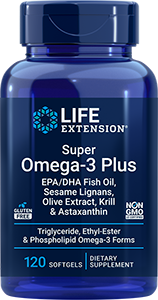Omega 3/6 Balance

Striking a Balance - Omega 3 & Omega 6 Fatty Acids
By J. Lang Wood
Though consumers hear a great deal about the benefits of omega-3 and omega-6 fatty acids, many people don’t know the difference between these two compounds nor how they act on the body.
The average American diet often contains 14 to 25 times more omega-6 fatty acids than omega-3 fatty acids. The recommended ratio should only be 2 to 4 times the amount of omega-6 to omega-3. Achieving the right balance of these two nutrients can help to ensure optimum health.
Omega-3 Fatty Acids
A number of studies indicate that omega-3 fatty acids play a role in reducing inflammation in blood vessels, joints and other areas of the body.
EPA, eicosapentaenoic acid, and DHA, docosahexaenoic acid, are two specific types of omega-3 fatty acids that play a crucial part in inflammation reduction. Alpha-linolenic acid, ALA, is another type of omega-3 fatty acid that is converted to EPA and DHA.
Products
What Are Their Importance?
Omega-3 fatty acids polyunsaturated fats that are important for many body functions, such as building cell membranes and controlling clotting. The human body cannot make its own omega-3 fatty acids, however, so people must get them from the foods they eat.
Increasing your intake of EPA and DHA in the form of fish of fish oil supplements can help to lower triglyceride levels and reduce your risk of heart attack, heart arrhythmias and stroke. These acids can also help reduce the buildup of plaque in blood vessels and lower blood pressure.
However, too much of these fatty acids can thin the blood too much and increase the risk of bleeding. Other benefits still under study are a reduction in certain cancers, improved bone health and lowered risk of complications of diabetes and certain metabolic disorders.
Foods With Omega-3 Fatty Acids
Foods that are rich in omega-3 fatty acids include flaxseed oil, fish oils, soybean oil, canola oil, walnuts and fish like salmon, herring, cod, mackerel or sardines. Even adding a small amount of omega-3 rich oils to your salad or in cooking can provide the health benefits.
Omega-6 Fatty Acids
The omega-6 fatty acids are polyunsaturated fats that contain linolenic acid and arachidomic acid. The average diet provides a sufficient amount of omega-6 fatty acids, and so using an omega-6 supplement is generally not necessary.
What Are Their Importance?
Omega-6 fatty acids, also known as n-6 fatty acids, can be particularly confusing. Some omega-6 fatty acids help to reduce inflammation. However, other types of omega-6 fatty acids can promote inflammation.
However, some conditions such as arthritis, diabetes or psoriasis can benefit from supplementation. Patients should always discuss taking supplements with their physician before taking them.
Foods With Omega-6 Fatty Acids
Foods that contain these acids include meat, eggs, poultry, corn oil, sunflower oil and safflower oil. Certain botanical oils are used as omega-6 fatty acid supplements, including evening primrose oil, black current oil and borage oil.
Unless your physician advises you to take omega-6 fatty acids for certain conditions, you should try to limit your consumption of these foods and supplements which Americans get in sufficient quantity in the foods they normally eat.



